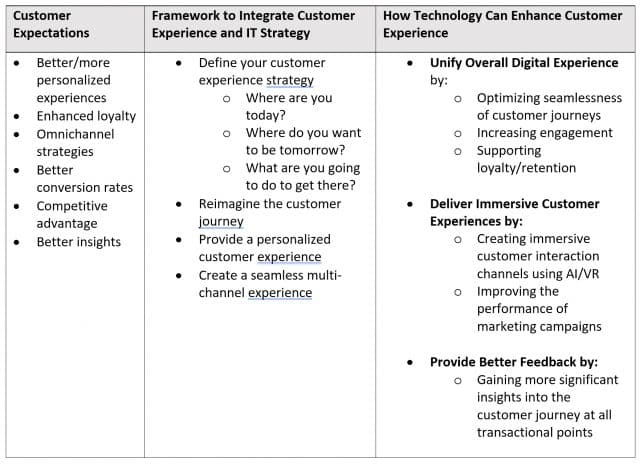The role of Information Technology in elevating customer experience

"Exceptional service" has always been a key customer demand over the years. But customers today expect more -- a combination of customized insights, connected interactions and an agile approach in addition to exceptional customer service. Therefore, while focusing on customer experience, communication and connection become highly crucial.
The recent pandemic and the process of businesses overcoming it have further brought to the spotlight the need for customer experience backed by flexible technology support and exceptional customer satisfaction, especially during adverse times. Information Technology (IT) has a significant role in providing the exceptional service and connected experience customers have always demanded.
The Digitally Conscious Customer and a Move Towards the "New Normal"
As technological developments became the savior of the business world during the worldwide lockdown due to the pandemic, more and more customers have now started to keenly focus on creating better digital workspaces for their enterprises. The pandemic has undoubtedly accelerated digital transformation projects across companies of all sizes and verticals, and organizations are interested in mapping their digital and business strategies now more than ever.
The top three priorities that define customer experience in the post-pandemic era are:
- Digital excellence
- Safe and contactless engagement
- Dynamic customer insights
Technology helps prioritize these critical aspects of customer experience by:
- Unifying Overall Digital Experience: By leveraging technology, omnichannel connects the data between various enterprise channels, making the complete history of a customer’s interactions visible to the agent. It helps recognize every stage in which a customer interacts with a service provider to have a seamless experience across all channels and devices. Customers are much happier when an agent/vendor can quickly get down to the business of solving their issues instead of asking for details they may have already provided through another channel.
- Creating Immersive Customer Experiences: As the pandemic prevents face-to-face meetings, digital improvements are expected to continue through 2021 and beyond. Therefore, businesses would benefit from automation support via "see what I see" (SWIS) technology. While augmented reality (AR) and mixed reality (MR) are being leveraged right now, they will be leveraged to a much greater degree in the future to create a more immersive customer interaction experience. Technology can improve this scenario by enabling customers to easily access knowledge and assist them through AR and MR.
- Providing Better Feedback: Technology makes it easier to collect and process input from all available sources for actionable insights. AI-enabled software and evolved BI setups convert qualitative input into quantitative insights using text and sentiment analysis in a timely and easy-to-comprehend manner.

The Starting Point for Creating a Framework to Integrate IT and Customer Experience
According to the Closing the delivery gap survey report by Bain & Co., while 80 percent of companies believe they have outstanding customer service, only 8 percent of customers believe they received excellent service. This is called the "customer experience gap."
The best way to bridge the customer experience gap is to collect and access clean data from every customer interaction. However, this is not always an easy task. Traditional databases are becoming increasingly complicated and less helpful in performing research, whether by humans or by sophisticated analytics engines. Therefore, the starting point towards creating a rich and rewarding customer experience is to devise a mechanism that allows everyone across the organization to see customer data (in accordance with their role). From this step onwards, customer experience technology must be leveraged at every step to personalize interactions and streamline customer transactions. The three pertinent questions that a technology leader should ask when looking at enhancing customer experience are:
- Where does my organization stand today in terms of customer experience?
- Where do we want to be tomorrow?
- What technologies are we going to leverage to cover the gap between the two, and how?
Customer Experience Will Eventually be the New Success Metric
Integrating technology into customer service for supplementing and improving customer experience is critical for a successful 2021 and beyond. Organizations are learning and leveraging new technologies and fresh ways of using legacy technologies to enhance consumer interactions and to enable new forms of collaboration in a world of unparalleled connectivity. By leveraging technology, organizations can not only amp up the customer experience; they can also get foresight into potential customer problems or concerns -- and resolve them in a timely manner. As the customer experience impacts customer behavior and hence, a company’s business, it will become a critical success metric in a matter of time.
Image Credit: Rawpixel / Shutterstock

Manan Thakkar is the Consulting Manager -- Business Process and Software Solutions (BPSS) and Business Analysis Practice Head at Synoptek, a leader in business and technology consulting, services and management for over two decades. He has over 20 years of techno-functional experience across multiple industry verticals such as manufacturing, healthcare, retail and banking.